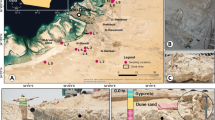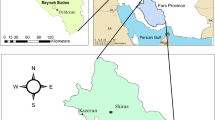Abstract
The slake durability test device was primarily designed for argillaceous rocks (clay-bearing) such as shale, claystone mudstone, and marl by Franklin and Chandra (Franklin JA, Chandra R (1972) The slake-durability test. Int J Rock Mech Min Sci 9:325–341). Later, the International Society for Rock Mechanics standardized the test method (ISRM (2007) The complete ISRM suggested methods for rock characterization, testing, and monitoring, 1974–2006. In: Ulusay R, Hudson JA, compilation arranged by the ISRM Turkish national group, Ankara, Turkey). The slake durability test is conducted to assess the durability offered by argillaceous rocks to degradation (slaking) when subjected to wetting–drying cycles (WD cycles). However, in previous decades two, various researchers also have used this test to assess non-argillaceous rocks. In this paper, the effects of the WD cycles and rock lumps abrasion (RLA) on the degradation of argillaceous and non-argillaceous rocks during the slake durability test are investigated. To this end, some marls and limestones (as argillaceous and non-argillaceous samples, respectively) were collected from rock trenches along roads in Lorestan province, west of Iran. The mineralogical studies were performed by microscopic thin sections and X-ray diffraction analyses (XRD). Also, physico-mechanical tests, including porosity (n) and point load index (PLI), and slake durability tests up to 15 cycles were carried out to characterize the samples. Results indicated that the degradation of argillaceous samples [assessed using slake durability index (SDI)] during the slake durability test was remarkably affected by WD cycles. Besides, the RLA showed less effect on the degradation of these samples. WD cycles had a preventative role in the degradation of the non-argillaceous samples, and only the RLA was responsible for the degradation of these sample types. The findings show that clay minerals in argillaceous samples make them highly susceptible to degradation by WD cycles. Moreover, the absence of these minerals in non-argillaceous samples has caused their degradation to be independent of the WD cycles. According to simple regression analyses, there is a good correlation between the degradation of the argillaceous samples with their saturated-to-dry PLI ratio (PLIr). However, no significant correlation existed between degradation and PLIr of the non-argillaceous samples. Overall, the PLIr can be considered a low-cost, rapid, and precise indicator to assess the degradation of the argillaceous samples during the slake durability test.
Highlights
-
The effect of the wetting-drying cycles (WD cycles) on the degradation of argillaceous and non-argillaceous rocks was investigated.
-
The degradation of argillaceous samples during the slake durability test was remarkably affected by WD cycles
-
The absence of clay minerals in non-argillaceous samples has caused their degradation to be independent of the WD cycles.
-
There is a good correlation between the degradation of the argillaceous samples with their saturated-to-dry PLI ratio (PLIr).
-
The PLIr can be considered a low-cost, rapid, and precise indicator to assess the degradation of the argillaceous samples during the slake durability test.














Similar content being viewed by others
References
Admassu Y, Shakoor A, Wells NA (2012) Evaluating selected factors affecting the depth of undercutting in rocks subject to differential weathering. Eng Geol 124:1–11
Anon (1979) Classification of rocks and soils for engineering geological mapping: part 1: Rock and soil materials. Bull Eng Geol Environ 19:355–371
Arman H, Abdelghany O, Saima MA, Aldahan A, Safwan Paramban S (2021) Slaking behavior of evaporitic rocks from Abu Dhabi area. United Arab Emirates Arab J Geosci 14:924
Azimian A, Ajalloeian R (2015) Empirical correlation of physical and mechanical properties of marly rocks with P wave velocity. Arab J Geosci 8:2069–2079
Broch E, Franklin JA (1972) The point-load strength test. Int J Rock Mech Min Sci 6:669–676
Cargill JS, Shakoor A (1990) Evaluation of empirical methods for measuring the uniaxial compressive strength of rock. Int J Rock Mech Min Sci Geomech Abstr 27:495–503
Cobanoglu I, Celik SB (2012) Determination of strength parameters and quality assessment of Denizli travertines (SW Turkey). Eng Geol 129:38–47
Dhakal G, Yoneda T, Kato M, Kaneko K (2002) Slake durability and mineralogical properties of some pyroclastic and sedimentary rocks. Eng Geol 65:31–45
Fereidooni D, Ghobadi MH (2005) Effect of mineralogy on durability and strength of hornfelsic rocks under acidic rainfall in urban areas. J Eng Geol 9:2765–2788
Fereidooni D, Khajevand R (2019) Utilization of the accelerated weathering test method for evaluating the durability of sedimentary rocks. Bull Eng Geol Environ 78:2697–2716
Franklin J, Chandra R (1972) The slake-durability test. Int J Rock Mech Min Sci 9:325–341
Fuenkajorn K (2011) Experimental assessment of long-term durability of some weak rocks. Bull Eng Geol Environ 70:203–211
Gamble JC (1971) Durability-plasticity classification of shales and other argillaceous rocks, Ph. D., thesis, University of Illinois, 159p
Gautam T, Shakoor A (2016) Comparing the slaking of clay-bearing rocks under laboratory conditions to slaking under natural climatic conditions. Rock Mech Rock Eng 49:19–31
Ghobadi MH, Momeni AA (2011) Assessment of granitic rocks degradability susceptive to acid solutions in urban areas. Environ Earth Sci 64:753–760
Ghobadi M, Mousavi S (2014) The effect of pH and salty solutions on durability of sandstones of the Aghajari Formation in Khouzestan province, southwest of Iran. Arab J Geosci 7:641–653
Ghobadi MH, Taleb Beydokhti AR, Nikudel MR, Asiabanha A, Karakus M (2016) The effect of freeze-thaw process on the physical and mechanical properties of tuff. Environ Earth Sci 75:846
Gupta V, Ahmed I (2007) The effect of pH of water and mineralogical properties on the slake durability (degradability) of different rocks from the Lesser Himalaya, India. Eng Geol 95:79–87
Heidari M, Momeni A, Mohebbi Y (2018) Durability assessment of clay-bearing soft rocks by using new decay index. Period Polytech Civ Eng 62:570–579
ISRM (1981) Rock characterization testing and monitoring. ISRM suggested methods. In: Brown ET (Ed), Pergamon Press, Oxford
ISRM (2007) The complete ISRM suggested methods for rock characterization, testing, and monitoring, 1974–2006. In: Ulusay R, Hudson JA (eds), compilation arranged by the ISRM Turkish national group, Ankara, Turkey
Jamshidi A (2022) A comparative study of point load index test procedures in predicting the uniaxial compressive strength of sandstones. Rock Mech Rock Eng 55:4507–4516
Jamshidi A, Zamanian H, Zarei Sahamieh R (2018) The effect of density and porosity on the correlation between uniaxial compressive strength and P-wave velocity. Rock Mech Rock Eng 51:1279–1286
Jiang H, Wang B, Inyang HI, Liu J, Gu K, Shi B (2013) Role of expansive soil and topography on slope failure and its countermeasures, Yun County, China. Eng Geol 152:155–161
Kahraman S, Fener M, Gunaydin O (2017) Estimating the uniaxial compressive strength of pyroclastic rocks from the slake durability index. Bull Eng Geol Environ 76:1107–1115
Kayabali K, Beyaz T, Kolay E (2006) The effect of the pH of the testing liquid on the slake durability of gypsum. Bull Eng Geol Environ 65:65–71
Khajevand R, Fereidooni D (2018) Assessing the empirical correlations between engineering properties and P wave velocity of some sedimentary rock samples from Damghan, northern Iran. Arab J Geosci 11:528
Khajevand R, Fereidooni D (2022) The effects of water acidity and engineering properties on rock durability. Earth Sci Res J 26:69–82
Khandelwal M (2013) Correlating P-wave velocity with the physico-mechanical properties of different rocks. Pure Appl Geophys 170:507–514
Kim TH, Cruden DM, Martin CD, Froese CR (2010) The 2007 fox creek landslide, peace river lowland, Alberta, Canada. Landslides 7:89–98
Li D, Wong LNY (2013) Point load test on meta-sedimentary rocks and correlation to UCS and BTS. Rock Mech Rock Eng 46:889–896
Luis I, de Vallejo G, Ferrer M (2011) Geological Engineering. CRC Press
Marques EAG, Vargas EDA, Antunes FS (2005) A study of the durability of some shales, mudrocks and siltstones from Brazil. Geotech Geol Eng 23:321–348
Miscevic P, Vlastelica G (2011) Durability Characterization of Marls from the Region of Dalmatia, Croatia. Geotech Geol Eng 29:771–781
Momeni A, Hashemi SS, Khanlari GR, Heidari M (2017) The effect of weathering on durability and deformability properties of granitoid rocks. Bull Eng Geol Environ 76:1037–1049
Monticelli JP, Ribeiro R, Futai M (2020) Relationship between durability index and uniaxial compressive strength of a gneissic rock at different weathering grades. Bull Eng Geol Environ 79:1381–1397
Niemann WL (2009) Lessons learned from rates of mudrock under cutting measured over two time periods. Environ Eng Geosci 15:117–131
Nikudel MR, Jamshidi A, Hafezi Moghaddas N (2011) An investigation on dissolution and decay of building stones in sulfuric and nitric acids solutions. Geosciences 20:135–142
Pettijohn FJ (1957) Sedimentary Rocks, 3rd edn. Harper and Row Publishers, New York, p 628p
Pirizadeh S, Sarikhani R, Jamshidi A, Ghassemi Dehnavi A (2022) Physico-mechanical properties of the sandstones and effect of salt crystallization on them: A comparative study between stable and unstable slopes (a case study of the Khorramabad-Zal highway in Iran). Case Stud Constr Mater 17:e01375
Sharma PK, Singh TN (2008) A correlation between P-wave velocity, impact strength index, slake durability index and uniaxial compressive strength. Bull Eng Geol Environ 67:17–22
Singh TN, Verma AK, Singh V, Sahu A (2005) Slake durability study of shaly rock and its predictions. Environ Geol 47:246–253
Taghipour M, Nikudel MR, Farhadian MB (2016) Engineering properties and durability of limestones used in Persepolis complex, Iran, against acid solutions. Bull Eng Geol Environ 75:967–978
Torabi-Kaveh M, Mehrnahad H, Morshedi S, Jamshidi A (2022) Investigating the durability of weak rocks to forecast their long-term behaviors. Bull Eng Geol Environ 81:8
Tugrul A, Zarif I (1998) The influence of mineralogical textural and chemical characteristics on the durability of selected sandstones in Istanbul, Turkey. Bull Eng Geol Environ 57:185–190
Vlastelica G, Miscevic P, Cvitanovic NS (2018) Durability of soft rocks in Eocene flysch formation (Dalmatia, Croatia). Eng Geol 245:207–217
Yagiz S (2011a) Correlation between slake durability and rock properties for some carbonate rocks. Bull Eng Geol Environ 70:377–383
Yagiz S (2011b) P-wave velocity test for assessment of geotechnical properties of some rock materials. Bull Mater Sci 34:947
Yagiz S (2018) The effect of pH of the testing liquid on the degradability of carbonate rocks. Geotech Geol Eng 36:2351–2363
Yilmaz I, Karacan E (2005) Slaking durability and its effect on the doline formation in the gypsum. Environ Geol 47:1010–1016. https://doi.org/10.1007/s00254-005-1234-1
Author information
Authors and Affiliations
Corresponding author
Ethics declarations
Conflict of interest
All authors declare that they have no conflict of interest.
Additional information
Publisher's Note
Springer Nature remains neutral with regard to jurisdictional claims in published maps and institutional affiliations.
Rights and permissions
Springer Nature or its licensor (e.g. a society or other partner) holds exclusive rights to this article under a publishing agreement with the author(s) or other rightsholder(s); author self-archiving of the accepted manuscript version of this article is solely governed by the terms of such publishing agreement and applicable law.
About this article
Cite this article
Jamshidi, A., Sedaghatnia, M. The Slake Durability of Argillaceous and Non-argillaceous Rocks: Insights From Effects of the Wetting–Drying and Rock Lumps Abrasion. Rock Mech Rock Eng 56, 5115–5131 (2023). https://doi.org/10.1007/s00603-023-03318-y
Received:
Accepted:
Published:
Issue Date:
DOI: https://doi.org/10.1007/s00603-023-03318-y




